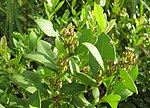
The Atlantic coastal pine barrens is a now rare temperate coniferous forest ecoregion of the Northeast United States distinguished by unique species and topographical features, generally nutrient-poor, often acidic soils and a pine tree distribution once controlled by frequent fires.
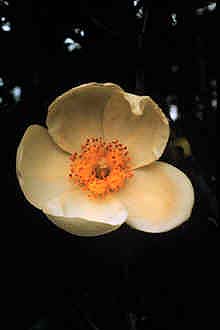
Gordonia lasianthus is a small to medium-sized evergreen tree or shrub found in acidic, swampy soils of pinelands and bays on the Atlantic and Gulf Coastal Plains of the southeastern United States. It is a member of the tea or family Theaceae. It is slow growing with soft, light-colored, fine-grained wood of little commercial value, although loblolly-bay could be managed as a source of pulpwood. When older specimens are cut, the wood exudes a strong scent. It is similar to a mixture of fresh oranges and pine sap. The bark of the adult tree varies from medium grey to a red brown coloration. Dead adult specimens of loblolly bay exhibit a lustrous shine when exposed to sunlight for several years. The white showy flowers and shiny foliage make it a desirable ornamental, but it is not easy to cultivate. Deer browse stump sprouts heavily.

Carya aquatica, the bitter pecan or water hickory, is a large tree, that can grow over 30 metres (98 ft) tall of the Juglandaceae or walnut family. In the American South it is a dominant plant species found on clay flats and backwater areas near streams and rivers. The species reproduces aggressively both by seed and sprouts from roots and from stumps of cut trees. Water hickory is a major component of wetland forests now in the south eastern US, because of the selective cutting of more desirable tree species for the lumber industry. It is considered important in cleansing drainage waters since the plants slow water flow during flooding, allowing sediments to fall out of the water column. This tree species is tolerant of wet soils but grows best on well draining soils near rivers and other water ways.

Lyonia is a genus of flowering plants in the family Ericaceae. There are about 35 species native to Asia and North America.

Lysimachia asperulifolia is a rare species of flowering plant in the Primulaceae known by the common name rough-leaved loosestrife and roughleaf yellow loosestrife. It is endemic to the Atlantic coastal plain in North Carolina and northern South Carolina in the United States, where there are 64 known populations. It is a federally listed endangered species of the United States.
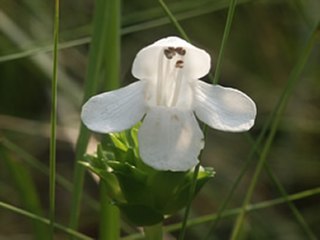
Macbridea alba is a rare species of flowering plant in the mint family known by the common name white birds-in-a-nest. It is endemic to Florida in the United States, where it is found in four counties in the Florida Panhandle. It is threatened by the loss and degradation of its habitat, and it is federally listed as a threatened species of the United States.
Arctostaphylos rubra is a species of flowering plant in the heath family and the genus Arctostaphylos, the manzanitas and bearberries. Common names include red fruit bearberry, alpine bearberry, arctic bearberry, red manzanita, and ravenberry. It is native to Eurasia and northern North America from Alaska through most of Canada to Greenland. There is also one population in the contiguous United States, located in the Absaroka Mountains of Wyoming.

Oxalis montana is a species of flowering plant in the family Oxalidaceae known by the common names mountain woodsorrel, wood shamrock, sours and white woodsorrel. It may also be called common woodsorrel, though this name also applies to its close relative, Oxalis acetosella.

Gaylussacia dumosa is a species of flowering plant in the heath family known by the common names dwarf huckleberry, bush huckleberry, and gopherberry. It is native to eastern North America from Newfoundland to Louisiana and Florida. It occurs along the coastal plain and in the mountains.

Gaylussacia frondosa is a species of flowering plant in the heath family known by the common names dangleberry and blue huckleberry. It is native to the eastern United States, where it occurs from New Hampshire to South Carolina.

Eubotrys racemosa is a species of flowering plant in the heath family known by the common names fetterbush, swamp doghobble, and swamp sweetbells.
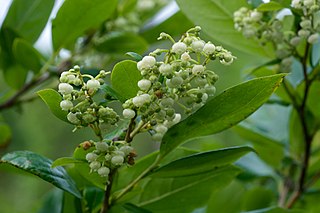
Lyonia ligustrina is a species of flowering plant in the family Ericaceae known by the common names maleberry and he-huckleberry. It is native to the eastern United States from Maine to Florida and west to Texas and Oklahoma.

Smilax laurifolia is a species of flowering plant in the greenbrier family known by the common names laurel greenbrier, laurelleaf greenbrier, bamboo vine, and blaspheme vine. It is native to the southeastern United States, where it occurs along the Gulf and Atlantic coastal plains from Texas to New Jersey, the range extending inland to Arkansas, Oklahoma, and Tennessee. It also occurs in Cuba and the Bahamas.

Vaccinium myrsinites is a species of flowering plant in the heath family known by the common name shiny blueberry. It is native to the southeastern United States from Alabama, Georgia, South Carolina and Florida. It may occur as far west as Louisiana.

Vaccinium pallidum is a species of flowering plant in the heath family known by the common names hillside blueberry, Blue Ridge blueberry, late lowbush blueberry, and early lowbush blueberry. It is native to central Canada (Ontario) and the central and eastern United States plus the Ozarks of Missouri, Arkansas, southeastern Kansas and eastern Oklahoma.
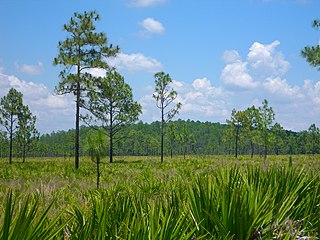
A cypress dome is a type of freshwater forested wetland, or a swamp, found in the southeastern part of the United States. They are dominated by the Taxodium spp., either the bald cypress, or pond cypress. The name comes from the dome-like shape of treetops, formed by smaller trees growing on the edge where the water is shallow while taller trees grow at the center in deeper water. They usually appear as circular, but if the center is too deep, they form a “doughnut” shape when viewed from above. Cypress domes are characteristically small compared to other swamps, however they can occur at a range of sizes, dependent on the depth.

Nyssa biflora, commonly referred to as the swamp tupelo, or swamp black-gum is a species of tupelo that lives in wetland habitats. Swamp tupelo grows chiefly in the coastal plains from Delaware, eastern Maryland, and southeastern Virginia, south to southern Florida and west to eastern Texas. Its range extends north up the Mississippi Valley to southern Arkansas and west and south Tennessee.

Vaccinium oxycoccos is a species of flowering plant in the heath family. It is known as small cranberry, marshberry, bog cranberry, swamp cranberry, or, particularly in Britain, just cranberry. It is widespread throughout the cool temperate northern hemisphere, including northern Europe, northern Asia and northern North America.

The Southeastern conifer forests are a temperate coniferous forest ecoregion of the southeastern United States. It is the largest conifer forest ecoregion east of the Mississippi River. It is also the southernmost instance of temperate coniferous forest within the Nearctic realm.

Lyonia mariana, the Piedmont staggerbush and staggerbush, is a perennial shrub that is native to the United States. Lyonia mariana, also known as the Piedmont staggerbush, is a shrub native to the southeastern United States, from Virginia to Florida. The shrub grows in habitats including pine flatwoods and sandhills, it displays adaptability to acidic soils. Recognized by its lance-shaped, glossy green leaves and clusters of white and pink tubular flowers, the Piedmont staggerbush contributes to the biodiversity of its ecosystem by providing shelter for wildlife and supporting pollinators. The plant contains grayanotoxins, making it potentially toxic if ingested.


